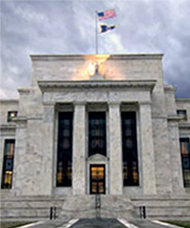The NY Fed has published a lengthy article focusing on the Reverse Repo (RRP) facility, “Overnight RRP Operations as a Monetary Policy Tool: Some Design Considerations”, Federal Reserve Bank of New York Staff Reports, Staff Report No. 712 February 2015. This is a two-part post on the research piece. The first post looks at the impact that the RRP has on the markets. The second looks at how the facility had been modified to address some of the perceived weaknesses and what risks those changes may create.
From the report:
“…In addition to improving the FOMC’s control over short-term interest rates, an RRP facility may have important secondary effects, with both positive and negative implications. In particular, an ON RRP facility could have repercussions for financial stability. These might include beneficial effects arising from the increased availability of safe, short-term assets to investors with cash management needs. However, there may be adverse effects stemming from the possibility that such a facility—particularly if it offers full allotment—could allow a very large, unexpected increase in ON RRP take-up that might enable disruptive flight-to-quality flows during periods of financial stress. In addition, very large usage of an ON RRP facility, particularly if it were permanently in place, would expand the Federal Reserve’s footprint in short-term funding markets and could alter the structure and functioning of those markets in ways that may be difficult to anticipate. Indeed, FOMC policymakers have expressed concerns about a sustained expansion of the Federal Reserve’s role in financial intermediation and the risk that ON RRPs might magnify strains in short-term funding markets during periods of financial stress (FOMC 2014a,b)…”
Some more specifics on the positive and negative effects of RRP:
“…One implication of a very large ON RRP facility would be the expansion of the Federal Reserve’s intermediation in short-term funding markets, which—particularly if such a facility were permanently in place—could alter financial markets in unpredictable ways…”
Ironically, the RRP could make a flight to safety too easy – although there is theory that points the other way too.
“…in times of financial stress, the facility’s counterparties could shift investments toward the facility and away from financial and nonfinancial corporations, possibly causing disruptions in funding that could magnify the stress…”
If RRP hangs around too long will this permanently impact how cash is recycled in the system, crowding out banks and other borrowers in the repo market? The Fed seems worried about that:
“…a permanent or long-lasting facility that causes very significant crowding out of short-term financing could lead to atrophying of the private infrastructure that supports these markets…”
although they also noted that so far there hasn’t been a major impact on repo overall or tri-party in particular. Instead, the Fed thought that as banks have decreased their repo books in response to regulatory pressure.
“…increasing ON RRP take-up since testing operations began in September 2013 has offset a fairly steep decline in government repo financing for private entities. So, in this case, increased ON RRP take-up may reflect in part the deleveraging of financial institutions, rather than the crowding out of private short-term financing…”
In our next post we will look at some of the modification the Fed has made to the RRP program and the trade-offs they create.


